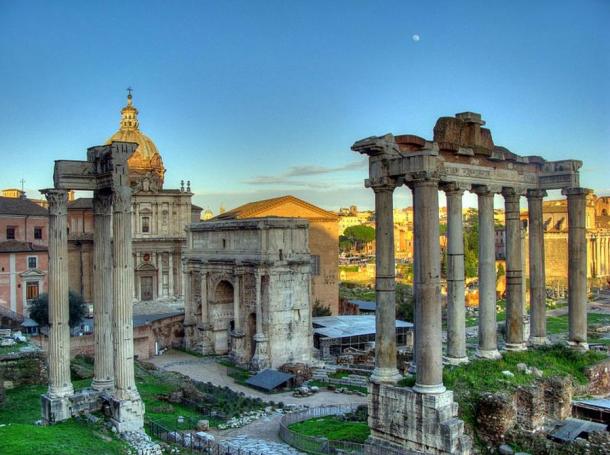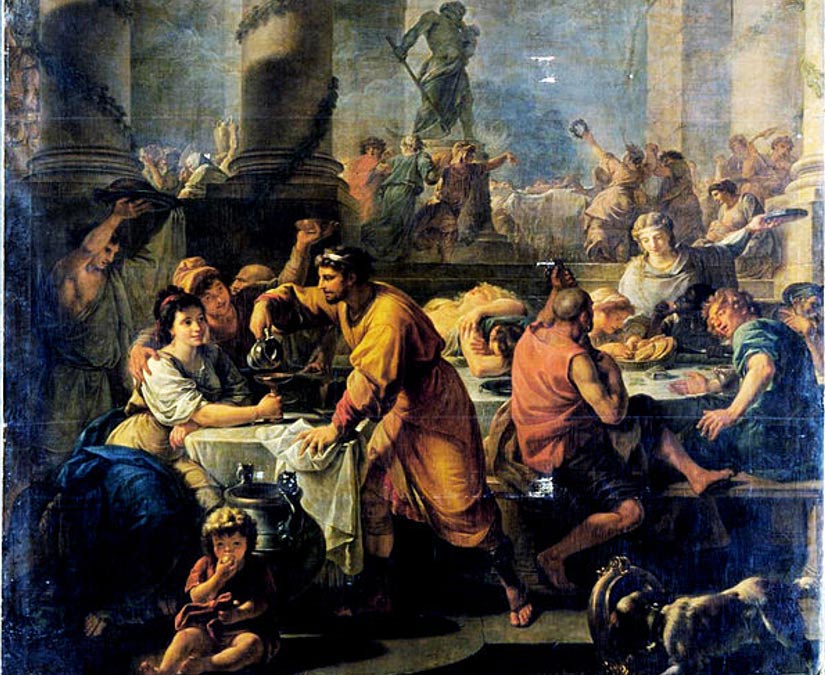Saturnalia: The December Festival of Joy and Merriment in Ancient Rome
Saturnalia was a festival celebrated by the ancient Romans. Originally, this celebration was held annually for a day on the 17th of December, but the festival was so popular that it was extended to a week (December 17-23). Despite efforts to reduce the length of the celebration - Augustus tried to reduce it to three days and Caligula attempted to cut it to five - the celebration of Saturnalia remained a weeklong event.
This was a period when the Romans indulged in oodles of joyous and merry activities – some may even call it excessive enjoyment. As Sir James Frazer puts it in his work, The Golden Bough, it was a time “when the darker passions find a vent which would never be allowed them in the more staid and sober course of ordinary life.”
Commemoration of the Roman Golden Age and Saturn
Saturnalia was celebrated in commemoration of the legendary Golden Age, a time in the past when, as Frazer wrote:
“the earth brought forth abundantly: no sound of war or discord troubled the happy world: no baleful love of lucre worked like poison in the blood of the industrious and contented peasantry. Slavery and private property were alike unknown: all men had all things in common.”
The Romans believed that during this Golden Age, Italy was ruled by the god Saturn (the Roman equivalent of the Greek Cronus). Saturn reigned as a righteous and benevolent king, and taught the inhabitants of Italy agriculture, while giving them laws. After the god vanished suddenly, his memory was kept by the people. One of the ways this was accomplished was through the celebration of Saturnalia.

Engraving of the god Saturn by Polidoro da Caravaggio. (Public Domain)
What are Saturnalia Rituals and Customs?
Saturnalia was designated as a holy day in the Roman calendar, hence religious rites would have been performed. For instance, sacrifices to Saturn would be performed according to Greek ritual, i.e. with the head uncovered. Another ritual performed during Saturnalia was the loosening of the woolen bonds which fettered the feet of the ivory cult statue in the Temple of Saturn. This was meant to symbolize the liberation of the god.

Ruins of the Temple of Saturn (eight columns to the far right), with three columns from the Temple of Vespasian and Titus (left) and the Arch of Septimius Severus (center). (Robert Lowe/CC BY 2.0)
In addition to being a holy day, Saturnalia was also a day of feasting and celebration. After the religious rites were completed, people would partake in a public banquet. There was also a lectisternium, a banquet in which an effigy of Saturn was a guest - as though the god was in attendance. According to the historian Livy, this practice was introduced in 217 BC:
“…a lectisternium was ordered (the senators prepared the couch), and a public banquet. For a day and a night the cry of the Saturnalia resounded through the City, and the people were ordered to make that day a festival and observe it as such for ever.”
- New Year’s Traditions around the World and Their Origins
- Why Christmas is held on 25th December
- The Ganymede Hypothesis - Part 1: The Original Double Solar System
- The Ancient Roots of Christmas Customs
Electing Saturnalia’s ‘King of Misrule’ and the Practice of Gift Giving
Another important aspect of the Saturnalia festival was the temporary inversion of the social order. For example, slaves would be treated as equals in remembrance of the Golden Age, when slavery was not known. Thus, slaves were allowed to wear nice clothes, to sit at the head of the table, to gamble, and basically to have time-off.
Additionally, a ‘King of Misrule’ was selected in each household on this day, and slaves were eligible as well. The ‘King of Misrule’ would have temporary authority to command the male head of the family, the paterfamilias, to do his bidding.

Roman fresco of dice players from the Osteria della Via di Mercurio in Pompeii. (Public Domain) Saturnalia was a “time-off” for slaves when they were allowed to wear nice clothes, to sit at the head of the table, and to gamble.
One Saturnalia practice which bears an uncanny resemblance to a Christmas tradition is the giving of gifts. The last day of the festival (December 23) was known as the Sigillaria (which means the ‘Day of Little Figurines’). Traditionally, people gave each other simple figurines made of wood, terracotta, or wax.
The symbolism of these figurines, however, is unclear, even to the ancient Romans. One interpretation, suggests these figurines were substitutes for the sacrificial victims once demanded by the cult of Saturn, while another has suggested that they were purely secular gifts. Over time, other gifts were also given, including, according to the poet Martial, writing-tablets, toothpicks, and an assortment of foods.
Pliny the Younger – An Ancient Scrooge
In short, Saturnalia was an extremely joyous celebration. Nevertheless, like all festivities, there were those who were not too fond of the merry-making. While the Victorians had the fictional character of Ebenezer Scrooge, the ancient Romans had a real curmudgeon in Pliny the Younger, who wrote:
“When I retire to this garden summer-house, I fancy myself a hundred miles away from my villa, and take especial pleasure in it at the feast of the Saturnalia, when, by the license of that festive season, every other part of my house resounds with my servants' mirth: thus I neither interrupt their amusement nor they my studies.”

Drawing of a drunken man being carried away by friends during Saturnalia. In the background someone watches them with an empty urn drooping from his hand. (1884) By John Reinhard Weguelin. (Public Domain)
Top Image: Painting entitled ‘Saturnalia’ (1783) by Antoine Callet. Source: Public Domain
By Ḏḥwty
Updated on December 17, 2020.
References
AshLl, 2014. On the Feast of Saturnalia, my master gave to me…. [Online]
Available at: http://www.ashmolean.org/ashwpress/latininscriptions/2014/12/12/on-the-feast-of-saturnalia-my-master-gave-to-me/
BBC, 2012. Did the Romans invent Christmas?. [Online]
Available at: http://www.bbc.co.uk/religion/0/20617780
Frazer, J. G., 1922. The Golden Bough: A Study in Magic and Religion. [Online]
Available at: http://www.sacred-texts.com/pag/frazer/
Gill, N. S., 2015. Saturnalia - Celebrate the Saturnalia. [Online]
Available at: http://ancienthistory.about.com/od/saturnalia/a/saturnalia.htm
Livy, History of Rome [Online]
[Roberts, W. M., (trans.), 1905. Livy’s History of Rome.]
Available at: http://mcadams.posc.mu.edu/txt/ah/Livy/
Martial, Epigrams: Book 7 [Online]
[Anon. (trans.), 1897. Martial’s Epigrams: Book 7]
Available at: http://www.tertullian.org/fathers/martial_epigrams_book07.htm
penelope.uchicago.edu, 2015. Saturnalia. [Online]
Available at:
http://penelope.uchicago.edu/~grout/encyclopaedia_romana/calendar/saturnalia.html
Pliny the Younger, Letters of Pliny [Online]
[Melmoth, W. (trans.), 1915. Pliny the Younger’s Letters of Pliny.]
Available at: http://www.gutenberg.org/files/2811/2811-h/2811-h.htm


















Comments
Hi All,
I have a few questions Is there any more information on this Saturn? Who was Saturn's parent's?
An when do the Oral Stories from the Romans share when Saturnalia disappeared? I'm curious because there has to be a Timeline of the Golden Age Saturn ushered in.
So that's all I wanted to know well until next time Everyone, Goodbye!
This is a very satisfying article! I hope to read more on this subject soon.
Muito bom este site.
The choice of 25 December for the celebration of the birth of Jesus is that the purpose was to Christianize the pagan festival in Rome of the Dies Natalis Solis Invicti, meaning "the birthday of the Unconquered Sun", or Sol Invictus, a festival inaugurated by the Roman emperor Aurelian (270–275) to celebrate the sun god and celebrated at the winter solstice, 25 December.
An explicit expression of this theory appears in an annotation of uncertain date added to a manuscript of a work by 12th-century Syrian bishop Jacob Bar-Salibi. The scribe who added it wrote: "It was a custom of the Pagans to celebrate on the same 25 December the birthday of the Sun, at which they kindled lights in token of festivity. In these solemnities and revelries the Christians also took part. Accordingly when the doctors of the Church perceived that the Christians had a leaning to this festival, they took counsel and resolved that the true Nativity should be solemnised on that day."
Wow, it's been a long time since I've been able to take some time to sit down and read an article! I'm glad I started with this one. I love the articles that have to do with holidays and celebrations! Our ancestors knew how to have a good time!!! :)
love, light and blessings
AB